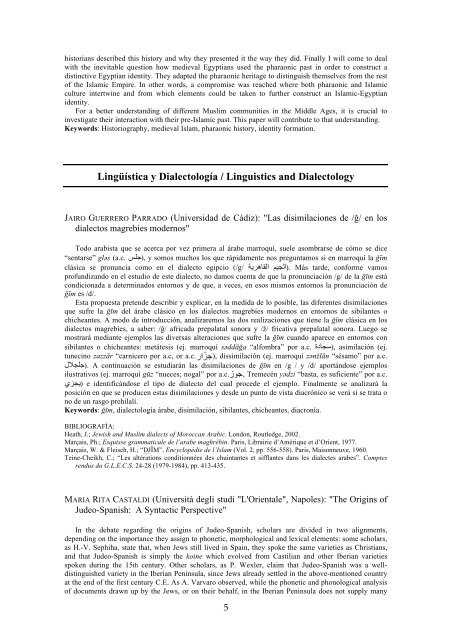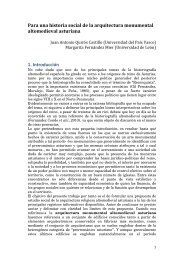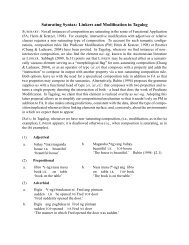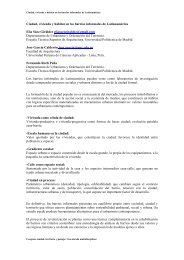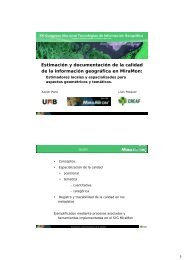Libro de resúmenes / Book of abstracts
Libro de resúmenes / Book of abstracts
Libro de resúmenes / Book of abstracts
Create successful ePaper yourself
Turn your PDF publications into a flip-book with our unique Google optimized e-Paper software.
historians <strong>de</strong>scribed this history and why they presented it the way they did. Finally I will come to <strong>de</strong>al<br />
with the inevitable question how medieval Egyptians used the pharaonic past in or<strong>de</strong>r to construct a<br />
distinctive Egyptian i<strong>de</strong>ntity. They adapted the pharaonic heritage to distinguish themselves from the rest<br />
<strong>of</strong> the Islamic Empire. In other words, a compromise was reached where both pharaonic and Islamic<br />
culture intertwine and from which elements could be taken to further construct an Islamic-Egyptian<br />
i<strong>de</strong>ntity.<br />
For a better un<strong>de</strong>rstanding <strong>of</strong> different Muslim communities in the Middle Ages, it is crucial to<br />
investigate their interaction with their pre-Islamic past. This paper will contribute to that un<strong>de</strong>rstanding.<br />
Keywords: Historiography, medieval Islam, pharaonic history, i<strong>de</strong>ntity formation.<br />
Lingüística y Dialectología / Linguistics and Dialectology<br />
<br />
<br />
JAIRO GUERRERO PARRADO (Universidad <strong>de</strong> Cádiz): "Las disimilaciones <strong>de</strong> /ǧ/ en los<br />
dialectos magrebíes mo<strong>de</strong>rnos"<br />
Todo arabista que se acerca por vez primera al árabe marroquí, suele asombrarse <strong>de</strong> cómo se dice<br />
“sentarse” gləs (a.c. سلج), y somos muchos los que rápidamente nos preguntamos si en marroquí la ğīm<br />
clásica se pronuncia como en el dialecto egipcio (/g/ ةيرھاقلا ميجلا). Más tar<strong>de</strong>, conforme vamos<br />
pr<strong>of</strong>undizando en el estudio <strong>de</strong> este dialecto, no damos cuenta <strong>de</strong> que la pronunciación /g/ <strong>de</strong> la ğīm está<br />
condicionada a <strong>de</strong>terminados entornos y <strong>de</strong> que, a veces, en esos mismos entornos la pronunciación <strong>de</strong><br />
ğīm es /d/.<br />
Esta propuesta preten<strong>de</strong> <strong>de</strong>scribir y explicar, en la medida <strong>de</strong> lo posible, las diferentes disimilaciones<br />
que sufre la ğīm <strong>de</strong>l árabe clásico en los dialectos magrebíes mo<strong>de</strong>rnos en entornos <strong>de</strong> sibilantes o<br />
chicheantes. A modo <strong>de</strong> introducción, analizaremos las dos realizaciones que tiene la ğīm clásica en los<br />
dialectos magrebíes, a saber: /ğ/ africada prepalatal sonora y /ž/ fricativa prepalatal sonora. Luego se<br />
mostrará mediante ejemplos las diversas alteraciones que sufre la ğīm cuando aparece en entornos con<br />
sibilantes o chicheantes: metátesis (ej. marroquí səddāğa “alfombra” por a.c. ةداجس), asimilación (ej.<br />
tunecino zazzār “carnicero por a.c, or a.c. ), dissimilación (ej. marroquí zənžlān “sésamo” por a.c.<br />
للاجلج). A continuación se estudiarán las disimilaciones <strong>de</strong> ğīm en /g / y /d/ aportándose ejemplos<br />
ilustrativos (ej. marroquí gūz “nueces; nogal” por a.c. زوج,<br />
Tremecén yədzi “basta, es suficiente” por a.c.<br />
يزجي) e i<strong>de</strong>ntificándose el tipo <strong>de</strong> dialecto <strong>de</strong>l cual proce<strong>de</strong> el ejemplo. Finalmente se analizará la<br />
posición en que se producen estas disimilaciones y <strong>de</strong>s<strong>de</strong> un punto <strong>de</strong> vista diacrónico se verá si se trata o<br />
no <strong>de</strong> un rasgo prehilalí.<br />
Keywords: ǧīm, dialectología árabe, disimilación, sibilantes, chicheantes, diacronía.<br />
BIBLIOGRAFÍA:<br />
Heath, J.; Jewish and Muslim dialects <strong>of</strong> Moroccan Arabic. London, Routledge, 2002.<br />
Marçais, Ph.; Esquisse grammaticale <strong>de</strong> l’arabe maghrébin. Paris, Librairie d’Amérique et d’Orient, 1977.<br />
Marçais, W. & Fleisch, H.; “DJĪM”, Encyclopédie <strong>de</strong> l’Islam (Vol. 2, pp. 556-558). Paris, Maisonneuve, 1960.<br />
Teine-Cheikh, C.; “Les altérations conditionnées <strong>de</strong>s chuintantes et sifflantes dans les dialectes arabes”. Comptes<br />
rendus du G.L.E.C.S. 24-28 (1979-1984), pp. 413-435.<br />
<br />
<br />
MARIA RITA CASTALDI (Università <strong>de</strong>gli studi "L'Orientale", Napoles): "The Origins <strong>of</strong><br />
Ju<strong>de</strong>o-Spanish: A Syntactic Perspective"<br />
In the <strong>de</strong>bate regarding the origins <strong>of</strong> Ju<strong>de</strong>o-Spanish, scholars are divi<strong>de</strong>d in two alignments,<br />
<strong>de</strong>pending on the importance they assign to phonetic, morphological and lexical elements: some scholars,<br />
as H.-V. Sephiha, state that, when Jews still lived in Spain, they spoke the same varieties as Christians,<br />
and that Ju<strong>de</strong>o-Spanish is simply the koine which evolved from Castilian and other Iberian varieties<br />
spoken during the 15th century. Other scholars, as P. Wexler, claim that Ju<strong>de</strong>o-Spanish was a welldistinguished<br />
variety in the Iberian Peninsula, since Jews already settled in the above-mentioned country<br />
at the end <strong>of</strong> the first century C.E. As A. Varvaro observed, while the phonetic and phonological analysis<br />
<strong>of</strong> documents drawn up by the Jews, or on their behalf, in the Iberian Peninsula does not supply many


